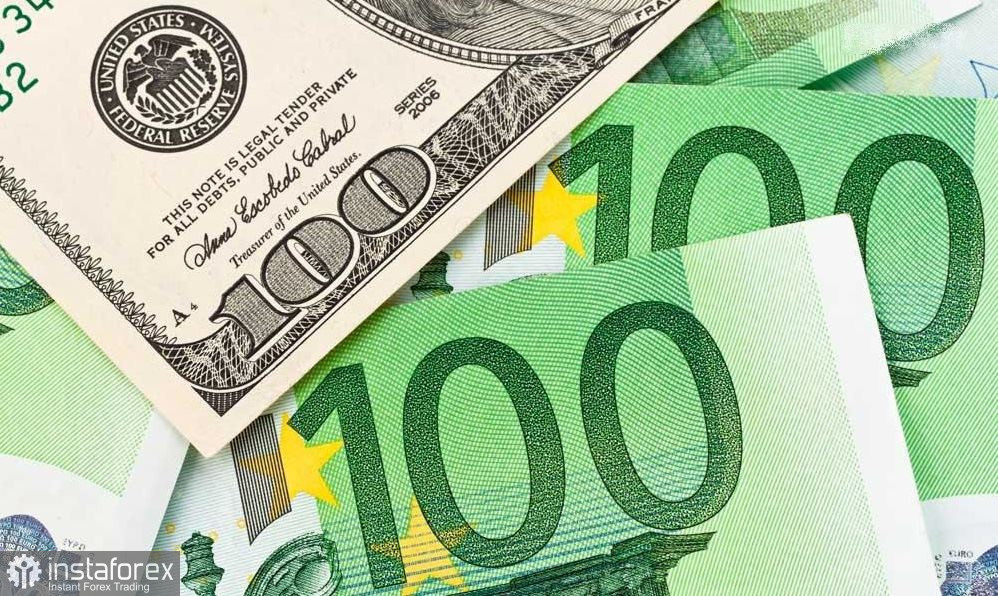Today, the euro/dollar pair updated its two-month low, falling to the base of the 8th figure. For nearly two weeks, the pair traded within the price range of 1.0850–1.0930, reflecting the indecision of both buyers and sellers. However, today, the bears made a southern breakthrough, surpassing the 1.0850 support level, which corresponds to the middle line of the Bollinger Bands on the four-hour chart. Although the pair couldn't reach 7-figure territory, the sentiment remains bearish.

Today's PMI data provoked the southern momentum of EUR/USD, which mostly landed in the "red zone." In particular, Germany's business activity index in the manufacturing sector came out at 39 points, indicating a deterioration in this area. This indicator has been below the key 50-point target for 14 consecutive months. Meanwhile, Germany's service sector business activity index dropped below the 50-point mark for the first time since January. The indicator has been decreasing for the third consecutive month (after six months of consistent growth) and, in August, re-entered the red zone, landing at 47.3, despite growth projections of 51.5 points.
The European-wide PMI indices mirrored Germany's trajectory. The manufacturing sector index has been below the "waterline" since June 2022 (reaching 43.7 points in August), while the service sector sharply dropped this month to 48.3 points (despite growth projections of 50.6 points) - marking the weakest outcome since March 2021.
Such results disappointed EUR/USD buyers, putting significant pressure on the pair. The gloomy August PMI indices reduced the likelihood of the ECB raising interest rates at the upcoming September meeting. Business activity in the Eurozone declined much more than expected, signaling intensifying issues in the European economy. Although the decline in Germany's (and the Eurozone's) manufacturing sector slowed, the service sector unexpectedly entered a contraction phase. Without exception, all August PMI indices for Germany, France, and the Eurozone are below the critical 50-point mark, indicating deterioration in the mentioned economic sectors.
Against the backdrop of such news, skepticism has returned to the market regarding hawkish outcomes from the ECB's September meeting. The probability of a 25 basis point rate hike next month has decreased to 35-40%, compared to a more than 50% probability noted yesterday. Market participants are now looking towards December, where the likelihood of a 25-point rate hike is estimated at 60%. However, there's still a lot of time until the December meeting, so discussing such distant prospects is premature.
Following today's reports, the yield on Eurozone government bonds has decreased (in particular, the yield on 10-year bonds, which serve as a benchmark for the Eurozone, plummeted by 12 basis points to 2.53% – the lowest level since August 10th), and the EUR/USD pair declined to the base of the 8th figure – the first time since June 14th of this year.
In other words, the catalyst for today's southern leap was the single currency, which responded quite painfully to the release of data on the growth of PMI indices in key European countries.
It is worth noting that it's still premature to dismiss a September rate hike, even though the likelihood of this scenario playing out has decreased after today's reports. Much (if not all) will depend on the dynamics of European inflation in August. We will learn about the August Consumer Price Index in the Eurozone quite soon – next week.
Recall that the general consumer price index dropped again in July, this time to 5.3%, after a decline to 5.5% in June. Despite the downward trend, the rate of decrease of the overall CPI has noticeably slowed down (for instance, in March, the indicator dropped straight to 6.9% from February's 8.5%, and in June, a decline to 5.5% was recorded from the previous 6.1%). However, the core consumer price index, excluding energy and food, remained at 5.5% in July (for the second consecutive month), against a forecasted minimal decline to 5.4%. If European inflation accelerates in August (especially concerning the core CPI), the intrigue regarding the outcomes of the September meeting will persist. Thus, it's premature to make far-reaching conclusions based on today's release. Nor should one consider selling at the peak of the southern impulse, as under current conditions, there's a risk of "catching the price bottom."
The EUR/USD is unlikely to stabilize at the base of the 8th figure: in anticipation of significant fundamental events (in this case, Jerome Powell's speech on Friday), such price movements aren't sustainable. Hence, the pair will soon return to the middle of the 8th figure. It's premature to discuss higher values, but southern prospects must also be more specific. In such uncertainty, it's prudent to maintain a wait-and-see stance on the pair: selling is risky in anticipation of the Federal Reserve Chairman's address, and buying is equally risky, essentially for the same reason. Jerome Powell will likely set the direction for the price movement. Still, at the moment, we are seeing impulsive and somewhat chaotic (emotional) price spurts, not conducive to making well-considered trading decisions.
 English
English 
 Русский
Русский Bahasa Indonesia
Bahasa Indonesia Bahasa Malay
Bahasa Malay ไทย
ไทย Español
Español Deutsch
Deutsch Български
Български Français
Français Tiếng Việt
Tiếng Việt 中文
中文 বাংলা
বাংলা हिन्दी
हिन्दी Čeština
Čeština Українська
Українська Română
Română

